PROFESSIONAL SOCCER IS SEEING A SUBSTANTIAL YOUTH MOVEMENT. BUT SHOULD IT?
By Jo Stephens
 By Nora Scully
By Nora Scully
SIGNATURE THEATRE'S PENELOPE IS A POIGNANT EXAMINATION OF UNRAVELING
By Hailey Wharram
THE DEATH OF DCIST SHOULD SCARE YOU
MARCH 22, 2024
13 sports
New season, new ambitions: Hoyas baseball looks to shine in new stadium

4 news Students show solidarity with workers as they negotiate new contract with Aramark
IMANI LIBURD
6 voices
An ode to ordinary people
OLIVIA POZEN
7 voices
When you’re not ‘LinkedIn’ to the Georgetown culture
KATE SATTERFIELD
8 features
Amid rise of antisemitism, Jewish students seek community
SYDNEY CARROLL
11
BRADSHAW CATE

12 leisure Signature Theatre’s Penelope is a poignant examination of unraveling
HAILEY WHARRAM
14 voices
The death of DCist should scare you
NORA SCULLY
15 editorials
It’s long past time Georgetown establish an ethnic studies program
EDITORIAL BOARD
“It’s our responsibility to be there for them in the same way that they are for us every single day,” Naughton said. “They wake up early, they go to sleep late just to ensure that we are fed, that we are taken care of. And I think it’s shameful if we don’t show up for them in the exact same way that they show up for us.”
PG. 4
Editor-In-Chief Graham Krewinghaus
Managing Editor Ajani Jones
internal resources
Executive Editor for Resources, Diversity, and Inclusion Lukas Soloman
Asst. Editor for RDI Aminah Malik
Editor for Sexual Violence Advocacy and Coverage Alison Karki
Service Chair Margaret Hartigan
Social Chair Bradshaw Cate, Jo Stephens Archivist Megan O'Malley news
Executive Editor Amber Xie
Features Editor Eddy Binford-Ross
News Editor Franziska Wild
Asst. News Editors Katie Doran, Sydney Carroll, Aashna Nadarajah
opinion
Executive Editor Barrett Ahn
Voices Editor Olivia Pozen
Asst. Voices Editors Eileen Miller, Alison Karki, Ali Chaudhry
Editorial Board Chair Sabrina Shaffer
Editorial Board Connor Martin, Brandon Wu, Nora Scully, Jupiter Huang, Lou Jacquin, Olivia Pozen, Lukas Soloman, Dane Tedder, Andrea Ho
leisure
Executive Editor Zach Warren Leisure Editor Hailey Wharram
Asst. Editors Nikki Farnham, Sofia Kemeny, Rhea Banerjee
Halftime Editor Eileen Chen
Asst. Halftime Editors Gabriel Mendoza, Sagun Shrestha, Francesca Theofilou
sports
Executive Editor Jo Stephens
Sports Editor Henry Skarecky
Asst. Editors Ben Jakabcsin, Andrew Swank, Langston Lee
Halftime Editor Bradshaw Cate
Asst. Halftime Editors Sam Lynch, Anna Cordova, Andrew Arnold
design
Executive Editor Grace Nuri
Design Editor Tina Solki
Spread Editors Olivia Li, Pia Cruz
Cover Editor Bahar Hassantash
Asst. Design Editors Rachel Zhang, Madeline Jones, Elin Choe copy
Copy Chief Cole Kindiger
Asst. Copy Editors Rania Khan, Maanasi Chintamani, Isabel Shepherd
multimedia
Multimedia Executive Connor Martin
Podcast Exec. Producer Romy Abu-Fadel
Podcast Editor Lucy Collins
Photo Editor Izzy Wagener
online
Online Executive Tyler Salensky
Website Editor Mj Morales
Social Media Editor Kristy Li
Asst. Social Media Editor Mark Manaois
business
General Manager Rovi Yu
Asst. Manager of Accounts and Sales Mini Xue
Asst. Manager of Alumni and Outreach Ninabella Arlis
support
Contributing Editors Adora Adeyemi, Angelena Bougiamas, Lou Jacquin, Lucie Peyrebrune, Nora Scully
Associate Editor
Staff Contributors Jack Kealey Meriam Ahmad, Carolina Bomeny, Mia Boykin, Elyza Bruce, Emma Cameron, Elspeth Campbell, Romita Chattaraj, Leon Cheung, Yihan Deng, Ryan Goodwin, Paul Kang, Julia Kelly, Ashley Kulberg, Imani Liburd, Rory Myers, Nicholas Romero, Carlos Rueda, Isabella Stratta, Kami Steffenauer, Amelia Wanamaker, Nadine Zakheim graphic
2 THE GEORGETOWN VOICE Contents contact us editor@georgetownvoice.com Leavey 424 Box 571066 Georgetown University 3700 O St. NW Washington, DC 20057 The opinions expressed in The Georgetown Voice do not necessarily represent the views of the administration, faculty, or students of Georgetown University, unless specifically stated. Columns, advertisements, cartoons, and opinion pieces do not necessarily reflect the views of the Editorial Board or the General Board of The Georgetown Voice. The university subscribes to the principle of responsible freedom of expression of its student editors. All materials copyright The Georgetown Voice, unless otherwise indicated. March 22, 2024 Volume 56 | Issue 12
10 halftime sports Professional soccer is seeing a substantial youth movement. But should it? JO STEPHENS
halftime sports Scaling the growing mountain of overconsumption
on the cover
BAHAR HASSANTASH
“Get Your Kicks”
ANDREW ARNOLD
by paul kang; layout by tina solki
by
Page 3
→ THE VOICE ’S PHOTO CONTEST: GEORGETOWN IN FULL BLOOM!
An eclectic collection of jokes, puns, doodles, playlists, and news clips from the collective mind of the Voice staff.
This spring, we are reviving our annual Photo Contest! So far in 2024, we've written many, many thousands of words. We want to make more space for those things that are worth just as much—pictures.
As winter melts away into spring, life on the Hilltop slowly becomes reinvigorated. With that, we want to encourage people to join in capturing life at Georgetown in full bloom. Submissions can be anything from nature scenery to mundane joy shared between friends to an evocative action shot and more. We are looking for meaningful, moving, creatively composed images.
• 1st place: $100 and your photo on the back cover of our next issue.
• 2nd and 3rd place: $25 each.
• Additionally, places 2 -5 will be featured within our next issue.
To enter, send photos in JPG format with associated titles/descriptions to photo@georgetownvoice.com with the subject line "Photo Contest Submission."
Submissions are due Thursday, April 4th, at 11:59 PM.
→ PIA’S B.L.T.* & FRANZI'S MESSAGE
*B.L.T., as in “breathtaking, lascivious, and tender.”


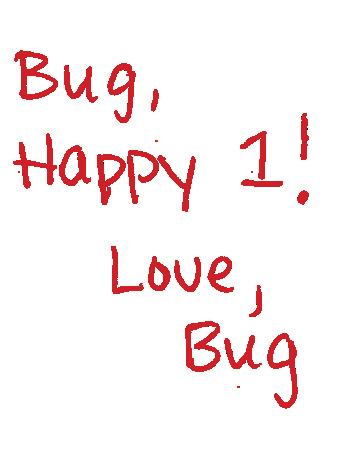
→ BRENDAN'S CROSSWORD

ACROSS:
1. Evil hidey-holes
5. Student mental health resource
9. Famous cookie peddler
11. Superstate in “1984”
13. See 14 Across
14. With 13 Across, process hinted at in highlighted clues
15. “His and ___”
16. Whippersnapper
17. Bruins great Bobby
18. Hullabaloo
19. Bygone
23. On the up-and-up
25. Currency of countries such as Jordan, Iraq, and Kuwait
26. Spoke 15-Down-ly
27. Granola-esque breakfast food
28. Guffaw
→ TUNE IN TO PODCASTS
Tune into the latest episode of Post Pitch hosted by Podcast Executive Producer Romy Abu-Fadel using the QR code:
→ CHECK OUT OUR NEWSLETTER
The Voice is coming to your inbox!
Subscribe to our new weekly newsletter at mail.georgetownvoice.com

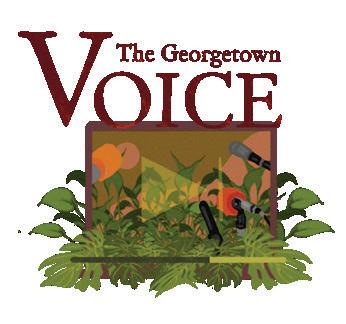
29. Wrote Giovanni’s Room, challenged by Florida’s “Don’t Say Gay” bill
31. Sicilian smoke spouter
32. Surfer’s dest., maybe
33. Polar opposite of WSW
34. Seething
37. Campus groups, shortly
38. Home of the Big Red
41. Conifer, for example
42. Deftness
43. Munich Mister
44. Bedecked
45. Two-tone treats from Nabisco
DOWN:
1. Lavatories
2. Query
3. Donning pre-commencement
4. Renowned Georgia arts school
5. Like bedframes that accomodate drapery
6. Young Skywalker’s nickname, in Star Wars: Episode I (1999)
7. Metal fastener
8. Droop in the middle
9. Deviating from the norm
10. Wrote The Bluest Eye, called “pornographic” by the Ohio Board of Education
12. Possible justification for the means
15. Grating, gruff
16. Per saying, preferential to being right
18. Food regimen
20. He who heeds (the call)
21. Wrote Catcher in the Rye, subject of trial Harris v. Mechanicville Central School District
22. Sets of three
24. Injured, as an ankle
25. Not the sharpest
27. Stallion’s mate
29. Wrote Kindred, deemed “unsafe” by North Carolina prison system
35. Hi-___ monitor
36. “Oh, and another thing...”
37. Miner’s finds
38. Ozone pollutant
39. Fuel, or fryer-fill
40. Carrier of genetic info
41. Albeit, textually
3 MARCH 22, 2024
crossword by brendan teehan; “ happy anniversary ” by franziska wild; newsletter graphic
deborah han;
“juicy b.l.t.” by pia cruz
Students show solidarity with workers as they negotiate new contract with Aramark
BY IMANI LIBURD
Students have rallied behind dining hall workers as they negotiate with Aramark, the company Georgetown contracts for dining services, for a new contract. Dining hall workers are demanding higher pay and improved benefits, and the first negotiation session was held on March 6.
Aramark has a history of allegations regarding poor labor practices. In 2015, the Voice found that Georgetown dining workers had a lower wage than dining workers employed by Aramark at nearby universities in the area, including American University and George Washington University.
Aramark representatives did not respond to multiple requests for comment, in person or by email.
Georgetown’s dining hall staff, including workers at the Leo J. O’Donovan Dining Hall (Leo’s), Epicurean & Company, the Leavey Center, and Einstein Bros. Bagels, are employed by Aramark and represented by the same labor union, UNITE HERE Local 23. The union currently represents nearly 25,000 workers, across multiple cities, who work in the service sector.
The contract between Georgetown’s unionized dining hall workers and Aramark expired at the end of 2023. Although the workers’ pay and benefits remain constant, the contract’s expiration prevents workers from receiving pay increases until they agree on a new contract. During this period, the clause that bans workers from striking is suspended and employers are prevented from withholding work as a bargaining chip in union negotiations.
Negotiations are ongoing and will probably require multiple sessions in order for an agreement to be reached. As they enter another session, students and UNITE HERE Local 23 want to ensure that Aramark bargains in good faith with workers.
“The biggest demands are going to be, one, for higher wages, people need to be paid more. Two, better health insurance or cheaper health insurance,” Josh Gavsie (CAS ’24), director of GCWR, said, adding that increased sick leave is another key demand.
GCWR actively meets with dining workers in meetings every other week throughout the semester, but will not be present for union negotiations. During these meetings, workers provide the members with updates about their experiences in their work environment.
According to GCWR and workers who spoke with the Voice, it has been challenging for workers to receive a schedule that allows them to work a full 40-hour work week within normal hours, something they hope a new contract will address. In order to reach a 40-hour work week, which due to inflation workers feel is necessary to provide for themselves and their families, many workers have to work night or weekend shifts under the current scheduling system.
“When you start work, you start working at the bottom. That means you work nights, you work weekends,” Catherine Anderson, a Leo’s dining worker, said. “I started out working at nighttime. I started out working every weekend. [Now,] to get 40 hours, you have to go back to nights, you have to go back to weekends. We don't really think that's fair. So that's one of the things that we want to fight very hard against.”
Many workers are unable to work at nighttime because they would have to find childcare or depend on public transportation to take them to and from work, according to Anderson.
According to Maya Garg (CAS ’26), a member of GCWR Facilities and Dining Committees, the high volume of temporary workers employed by Aramark has prevented full-time employees from working the number of hours they would like.
In order for an employee to receive holiday pay, they must be present and on time the day before and the day after the holiday.
This late policy has penalized workers in the past, Anderson said, resulting in them missing out on significant amounts of holiday pay. For example, during COVID, Aramark paid holidays for Thanksgiving, Christmas, New Year’s Day, and Martin Luther King Jr. Day in one payment, and according to Anderson, one employee didn’t receive any holiday pay for those four days because she was three minutes late on a single day.
Daily and weekly job assignments for employees also lack consistency. Aramark regularly rotates workers between dining locations in a specific building, or between completely separate buildings.
“During those 38-39 hours that a worker might be in Leo’s or something like that, they are being asked to do six different jobs that might have different pay scales,” Matt Dame (CAS ’27), a member of GCWR’s Facilities, Dining, and Events Committees, said.
Interviewed workers confirmed that employees have to work several different jobs in a week due to understaffing issues, meaning they are sometimes assigned to positions they have no experience working, leading to a stressful work experience.
Beyond having to perform various roles in one shift or work week, GCWR members said that dining workers are required to work in unsafe and unhealthy working conditions. These conditions also place the student body and other members of the Georgetown community who receive food from these locations at risk. GCWR members hope that the solidarity statement will help pressure Aramark into improving health and sanitation standards for dining workers.
The Georgetown Coalition for Workers’ Rights (GCWR), a student group, released a solidarity statement on Feb. 9 in support of workers. The statement aims to demonstrate the solidarity between the Georgetown community and the dining hall staff, given what GCWR describes as the continued mistreatment of workers.
Interviewed workers said that most employees are only scheduled to work 30-37 hours a week, despite their desire to work a full 40 hours.
Dining workers are also attempting to change the current late policy for their new contract. Currently, Aramark gives a six-minute grace period; when an employee comes in after that period, they are marked as late in the system.
“In Leo's, they have their break room, where they eat all their meals, very close to a dumpster outside, and so there are mice and rats that come into where they're eating, and it's supposed to be a clean space,” Garg said. “Or in Starbucks, they have cold water in the back room where you're supposed to be washing dishes and things, and you need hot water for that. They're washing things constantly in cold water, which is both unsafe for them and unsanitary.”

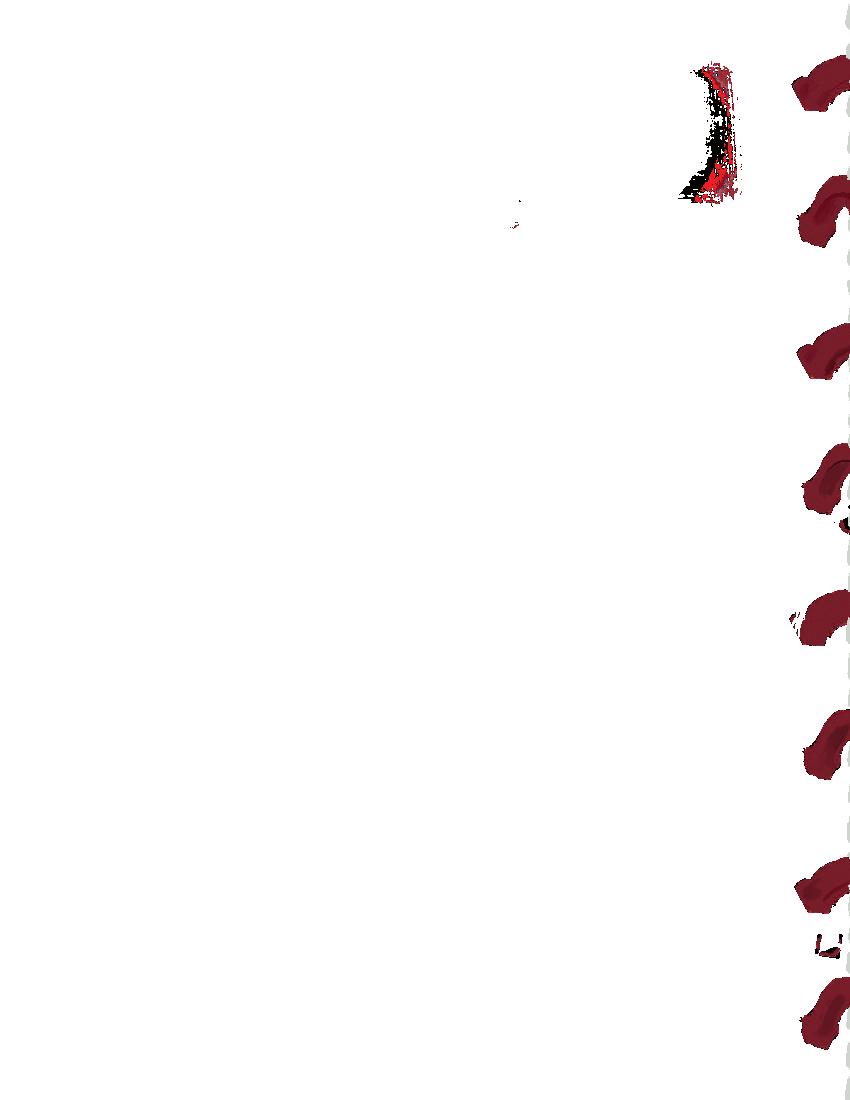

THE GEORGETOWN VOICE design by rory myers

Additionally, workers claim that Aramark’s management has treated them poorly, an issue that they plan on addressing during negotiations. A cook at Leo’s, who spoke with the Voice under the condition of anonymity for fear of retribution, said that managers often curse workers out, show favoritism towards some workers, and don’t supply the workers with the necessary ingredients for a menu, expecting them to improvise. She also mentioned that she and other workers have had little success escalating their concerns about mistreatment.
“People have been mistreated, and stuff like that. It’s a lot of disrespect on the job and that’s something that we’re going to fight hard to take care of,” the cook at Leo's said. “Even if we have to go to the human resources office, and they're gonna have to get involved. We come to work hard every day, and we don't deserve to get disrespected.”
GCWR members also acknowledged the role students and other community members play in treating workers badly. While this issue isn’t the primary focus in the negotiations, GCWR representatives believe it's an important issue worth addressing and see this as an appropriate time to begin the conversation amongst the student body.
“Most people overlook the contributions made by facilities staff, whether it be housekeeping and maintenance [or] keeping the gardens running. They overlook the contributions of the dining staff [who ensure] that people are fed for multiple meals every day. And that's unacceptable,” Gavsie said.
Members of GCWR are hopeful that the university will also show its support for workers' demands. The solidarity statement received 492 signatures from students, 42 signatures from faculty, and support from 11 student organizations. Students delivered the statement to Aramark’s management in Leo’s on Feb. 29.
Although the university does not directly employ dining hall workers, Aramark is contracted by Georgetown, and students believe the university has some leverage over how Aramark behaves during negotiations. In 2020, the Voice found that Georgetown provides Aramark with $26,134,459 annually for dining hall services.
“[Georgetown has] the ability to dictate what Aramark ultimately does, and especially in this bargaining process, even though it is between Aramark and the union,” Fiona Naughton (SFS ’26), member of the GCWR Steering Committee, said. “Georgetown has the ability and the power and the prerogative to say to Aramark, ‘You have to respect these rights, and you have to bargain in good faith,’ to ensure that this new contract will be even better for workers than the previous contracts.”
“Georgetown University is committed to ensuring workers are treated fairly under our Just Employment Policy and works with contractors like Aramark on campus to ensure compliance with the policy, which requires contractors to
provide a greater total compensation package than called for by existing metro-area wage ordinances,” a university spokesperson wrote in an email to the Voice.
GCWR members also hope the university will support dining workers based on its policies, past stances, and values.
“We're emphasizing Jesuit values, or the stances that Georgetown has taken in the past that have been pro-labor and pro-workers’ rights,” Dame said.
The statement’s writers stressed the need to show the university that students stand with dining hall workers and will not allow their continued mistreatment.
“It puts you in a lot better position to fight with a lot of people behind you than it is with few, and to show that the entire university body is behind our dining workers as they fight for another contract, it’s really the least you can do as students,” Xavi Molina (CAS ’25), member of the GCWR Facilities Committee, said.
For many members of GCWR, this fight is personal. They have formed connections with the dining workers who serve the Georgetown community and want to ensure that they are treated fairly.
“Generally, this campus makes it very easy to invisibilize the workers around us, and there is this assumption that we are a homogenous student body who does not have anything in common with these folks,” Molina said. “That has been upsetting to me since I've come here because I think, since my first day as a freshman at this dorm, the folks who were cleaning my hallways felt more familiar to me than the people who were sleeping next door.”
Workers expressed appreciation that students have organized to support them.
“It's so nice to know that the students are giving us support because their voice matters to us a lot. That's why we come in every day: because of the students,” the cook at Leo’s said.
Workers also acknowledged the support from faculty members when they come to the dining halls and talk to workers.
Organizers hope that the Georgetown community will recognize the many sacrifices dining workers make for students, and that this will mobilize community members to show support.
“It’s our responsibility to be there for them in the same way that they are for us every single day,” Naughton said. “They wake up early, they
“They took the time to come and listen to what we had to say. They offered a lot of words of encouragement. They spoke up for us and they let management know that this is a campus where everyone should be treated fairly,” Anderson said.

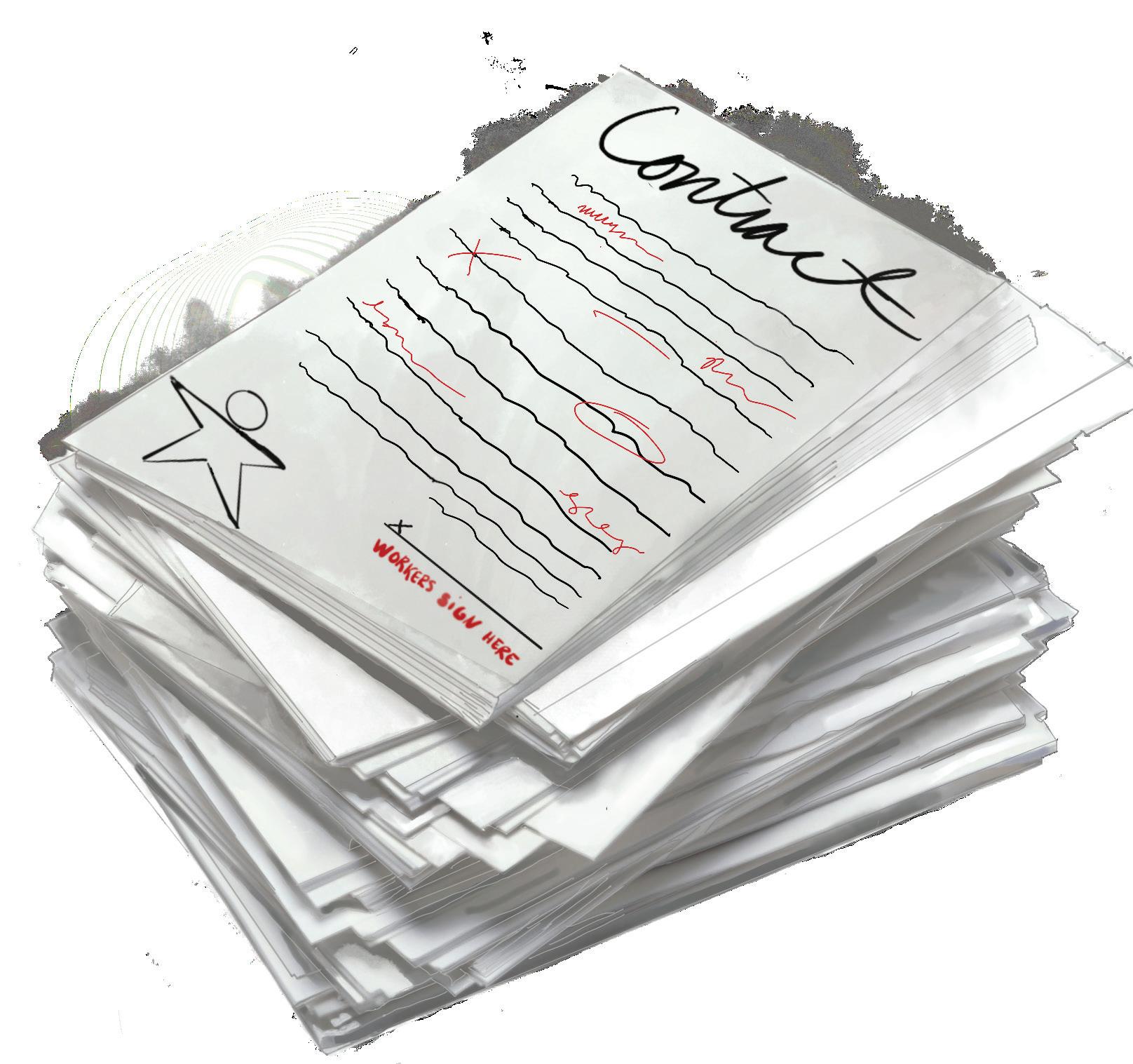



MARCH 22, 2024 5
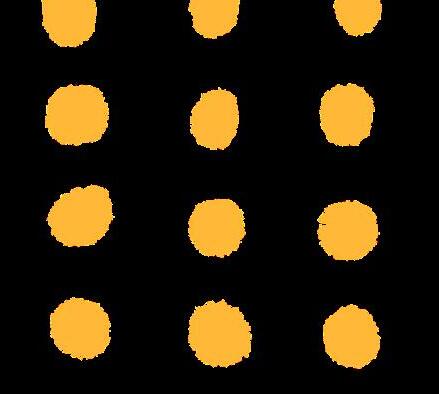

Last summer, I attended the Boston Latin School’s production of Matilda: The Musical, and the day after that I drove past a skatepark somewhere that I’ve since forgotten. In the grand scheme of my summer months, neither of these were particularly noteworthy highlights. Regardless, these interactions sparked a brief sense of awe and appreciation for what we so often overlook.
While my involvement is certainly limited at best, neither the worlds of recreational theater nor skateboarding are entirely foreign to me. There was a point in my life when I sang and I knew how to warm up my vocal cords; sometimes I would post little snippets on my Instagram stories and I’d be quietly thrilled when I received praise. But I struggled with learning how to act as I sang, how to choose my note placement, and a slew of other technical things that my middle school theater days did not teach me. As such, during my senior year of high school, I unsuccessfully auditioned for my school’s cabaret troupe, marking my final failed attempt to crack the artistic boundary and join the world of organized theater. Theater is beautiful and artistic but simultaneously extremely difficult—it requires a precision that the audience doesn’t quite notice.

Skateboarding, similarly, is a deceptively onerous task, necessitating intense training and skill unseen by onlooking eyes. I was a tomboy growing up, and there was nothing I loved more than my skateboard (which I painted myself, might I add). I could guide myself down steep hills and successfully stop at the bottom and, wearing my polkadotted helmet, I felt like I could conquer the world. Regardless, I tried and failed on countless occasions to learn how to do an ollie, the most elementary trick off of which most of the professional sport is built.



I find that there’s something really special about local theater performances and afternoons at the skatepark and similarly small and insignificant things. They’re the moments we forget about if we don’t think hard enough, but they contain a sense of wonder and whimsy, an appreciation for the ordinary and oft undervalued.
There are a million little high schools across the country and a million little theater departments and a million little students playing Matilda or Wednesday Addams or Jack Kelly, and the best part is, they’re good. The vast majority of them will end their theater careers when they graduate, but, at least for a while, their talents shine on the stage. These students aren’t the one-in-a-million miracle children that will make it to Broadway, but it doesn’t particularly matter because, for the time being, they can still make an audience smile or laugh or cry (or your other favorite verb).



that “sticks,” something they may succeed in further down the line. Suddenly, they feel no desire to continue anything at which they don’t prove to be “special” and are later plagued by intense imposter syndrome when they compare themselves to peers.
This overachiever mentality is especially prevalent at Georgetown, where our extracurricular activities revolve almost entirely around developing future career skills. Notoriously competitive clubs from debate societies to cosplay venture capital firms have become an outlet for our “exceptional” talents—we seek professional spaces to further hone our abilities, ascending scaledfor-size corporate ladders and adding to our resumes as we do it. But isn’t college meant to be a time for exploration? A time to pull on threads and fall down rabbit holes and experiment with one-off niches?
Similarly, my brother’s favorite skatepark in Waltham is always packed with people maneuvering their way around concrete features and obstacles, bustling even as the sky keels over into deep navy blues. These people are no competition winners or X Games athletes. But, extraordinarily, these 20-something, rotating, random individuals can all kickflip and backslide down rails and drop into quarter pipes and complete what are objectively difficult tasks. And so can the attendees of the skatepark in the next town over. And the next one. And the next one.
As college students, we no longer find the same enthusiasm for hobbies we deem amateur or unproductive. We’ve created a culture that is so focused on hyperproductivity and upward mobility that we no longer value the mediocre, instead believing that you must attempt to be the best at anything you’re tentatively skilled at. Parents enter their children into swaths of sports and classes when they’re younger, allowing them to dabble and dip their toes into just about anything. Yet, somewhere around fifth grade, activities begin to offer specialty tracks (I fell victim to the club soccer pipeline). These same children are consequently pigeonholed into seemingly innocuous quests to find something
Though we’ve convinced ourselves that it’s simply too late to take up new hobbies, we might just be afraid of failing at something. But we must conquer our fears of inadequacy. It’s okay to not immediately succeed, and there’s merit in struggling with something but choosing to immerse yourself anyway. Growth takes time, and we must give ourselves grace as we seek to learn, practice, and eventually improve. And even if you quite literally suck, do it anyway! Dance on an elevated surface even if you’re uncoordinated. Sing at a karaoke bar even if you’re desperately off-key. Pick up a tennis racket even if you’ve never played. Ability and enrichment don’t have to go hand-in-hand.
I think it’s exhilarating to watch someone love something for the sake of loving it. The vast majority of people aren’t professionals, nor do they receive substantial praise or recognition for fascinating, yet ultimately ordinary, talents. They don’t try to market their hobbies, instead embracing the important realization that it’s okay to just be okay at things. They stick with their passions because they love them and because they can. At the end of the day, all we can do is strive to be a little better than we were the day before.

There’s so much extraordinary in the ordinary that we don’t initially realize. But we should come to appreciate it just the same. G

6 THE GEORGETOWN VOICE VOICES design by maggie zhang

When you’re not ‘LinkedIn’ to the Georgetown culture
BY KATE SATTERFIELD
Vil A Rooftop, circa September 2023: “can I get your LinkedIn?”
A bizarre question to come out of an 18-year-old’s mouth. I’m briefly shocked into a stunned silence: did he really just ask me for my LinkedIn? What is the response to that?
Unfortunately, this is an all too common experience for many on Georgetown’s campus. LinkedIn’s iron grip on the Georgetown population spans all years, majors, and schools. The obsession with Corporate America™ heightens in every babyfaced freshman as soon as they pass through Healy’s hallowed halls. From vying for unpaid positions in coveted consulting clubs to near fistfights over the front-row seat in IR lectures, Georgetown culture is defined not just by how well-connected you are, but how you subsequently climb the social ladder. And what better way to connect yourself than via the only app used equally by boomers and Gen Zers alike?
As a public school kid from the South, LinkedIn was as foreign as good pizza and public transportation. Most people I knew from home didn’t even have a LinkedIn profile. I know I certainly didn’t. I made a profile the summer before freshman fall and copied my dad’s—he and my mom were my first (and only) connections. As such, it’s hard not to feel woefully incompetent when faced with my over-eager peers who tout over 300 connections within their first month here. We can’t even legally drink yet; what do you mean you have three years of experience in legislative internships? Since when does everyone have professional headshots?
These are questions that I frankly still don’t have answers to. Since February, my LinkedIn profile has been blessedly updated and I have added to my meager two connections; unfortunately, I am still unsure of how to actually operate the app. I accidentally posted a job update to my feed that I don’t know how to take down. Both my mom and dad commented and liked it. I find myself stalking friends’ and acquaintances’ profiles, memorizing and
mimicking their professional word choice— this was, of course, before I learned that you can see who views your profile. But maybe I wouldn’t be so inept at networking if I actually had people to teach me. Everyone must’ve learned somewhere—nobody spawns into existence with both the charisma of Frank Sinatra and the business know-how of Jeff Bezos. So why isn’t Georgetown doing more to uplift its less-connected students?
The reality is that Georgetown doesn’t do nearly enough to support the majority of its population, leaving someone like me—who didn’t go to a private college preparatory school or have nepotistic connections to government higher-ups—unable to take full advantage of the Georgetown network. We have some of the most well-connected alumni in the world, but you wouldn’t know it if all you had to depend on was the Cawley Career Center and some casual conversation skills. Don’t get me wrong, the Career Center is all well and good, but it’s not going to get you that McKinsey position or State Department internship that we all crave. To be a Georgetown student and do it “right,” you have to play the game. The game, of course, is schmoozing and networking—deceptively easy and not at all fair. Those of us who were not trained to treat every conversation like a potential business deal simply won’t, and we’ll inevitably miss out on those chances for future progress. Meanwhile, those who are “LinkedIn” will continue to climb the corporate (or government) ladder.
While Georgetown’s unique LinkedIn culture is strange, I don’t believe that it’s necessarily a bad kind of strange. It’s one thing to entirely base your life around your LinkedIn profile, but there certainly are benefits to getting a headstart on your career. I’ve used the feature that recommends people to connect with as a way to reach out to those I’d only met in passing, and it allows me to get a sense of what my peers are pursuing professionally. But it also gets overwhelming.
Yes, it’s important to be involved on campus, get the internship, and meet the right people—but we’re still so young, way too young to be using terms like “deliverable” unironically. There’s absolutely no need to have our 20-year career paths planned out to a T. This is our test run for the real world, a time to experiment and learn. The blunders are just as developmentally important as the coffee chats and office hours. Curate your LinkedIn (but don’t give it out at rooftop parties), put away the Western business attire, and cancel the subscription to that resume-builder website. We have the rest of our lives to get to 1,000 connections; enjoy college.
However, I doubt that this advice will be taken to heart, and the vast majority of us will continue our quest for political infamy— Lockheed Martin is one of Georgetown’s biggest recruiters for a reason. And, though I’m diametrically opposed to joining the workforce before I’ve beaten teen pregnancy, I’ve been trying (and failing) to use LinkedIn’s “job search” function daily to find summer jobs. I’m rightfully off-put by Georgetown’s pre-professional culture, but what do you do when you can’t beat them? You join them.
You could join more “chill” clubs that don’t require three rounds of interrogation and still offer mentorship and guidance. These clubs—and they do exist—offer a supportive environment minus the cutthroat The Devil Wears Prada (2006)-esque interpersonal relations. Or, you could start networking on a smaller scale. Befriend those you know who have connections on LinkedIn, meet their connections, and make them your connections. Yes, LinkedIn sucks; but as long as it’s here, we might as well take advantage of it. If you do, you could have a veritable army of potential bosses, recruiters, and recommenders willing to vouch for you. Is using your friends for their connections gold-digging? Maybe. Is it what everyone else does? Absolutely. It’s easier said than done, no doubt about it. But to win the game, you’ve gotta play the game. G
design by madeline jones MARCH 22, 2024 7
VOICES
Amid rise of antisemitism, Jewish students seek community
BY SYDNEY CARROLL
Every Friday, Madison Lieberman (CAS ’24) walks to Chabad Georgetown, where she attends Shabbat, a Jewish service celebrating a weekly day of rest. For Lieberman, the ability to connect with her religion has been a lifeline throughout her college experience.
“It’s family,” Lieberman said. “Everybody’s amazing—I met one of my best friends through Chabad.”
At Shabbat services, Lieberman wears a necklace with a Star of David charm. She used to wear it all the time, but recently, she feels that the display of Jewish pride puts her at risk of antisemitism.
“If I’m going out with my friends at 2 o’clock at the bar, I take it off,” Lieberman said. “It’s scary, and it’s not something anybody should have to worry about—Jews or any other group.”
In the months following Hamas’s Oct. 7 attack and Israel’s subsequent invasion of Gaza, Jewish students across the country, including at Georgetown, have reported increased antisemitism. Jewish students who spoke to the Voice shared experiences of being called slurs, being profiled, having fear of speaking about their Judaism, and seeing antisemitic sentiment in online spaces.
The Jewish community has also faced internal challenges and fractures caused by polarizing discussions about Israel and its connection to Jewish identity. These conflicts have led individuals to find solace and meaningful connections in a variety of groups rather than under one umbrella.
Antisemitism has been prevalent on Georgetown’s campus for many years. In January 2023, antisemitic and racist pamphlets were distributed across campus, including within Bayit, Georgetown’s Jewish Living Learning Community. In the same month, students discovered antisemitic graffiti drawn in Darnall Hall following similar incidents in 2022, 2017, 2010, and 2009. A staff member in the SFS was placed on leave in November of 2023 after past antisemitic tweets surfaced.
But in January, the threat of antisemitic violence hit much closer to home for many. Two months ago, a Lyft driver allegedly attacked Rabbi Menachem Shemtov—the founder and director of Chabad Georgetown—by striking him several times. Metropolitan Police later arrested the driver, who was charged last month
in D.C. Superior Court. According to court documents, authorities believe he was attacked because he is Jewish.
Shemtov and his wife, Racheli, run Georgetown’s chapter of Chabad. Its website describes its mission as “to treat every Jew with love and care and to inspire them to embrace and be proud of their Judaism.”
The attack has not deterred Shemtov from fulfilling that goal.
“What happened was awful, but it doesn’t make me any less proud to be Jewish,” Shemtov told the Voice. “In the face of antisemitism and hatred, we must move forward with pride and ensure that fear doesn’t stop us from living as a proud Jewish community.”
The threat of antisemitism has made physical gatherings more difficult for the Jewish community. The doors to Makom, the campus’s Jewish gathering space, are locked with a deadbolt and several padlocks outside of organized events. While other religious spaces on campus like Dahlgren Chapel remain open to visitors 24/7, given recent antisemitic attacks on other Jewish gathering spaces across the country, Makom’s doors remain closed unless the space is in use for an event.
For Georgetown’s Jewish students, times of increased fear and antisemitism have made community gatherings at Makom, Chabad, and other spaces more important.
The Friday following Oct. 7, Anjali Ofori (CAS ’27) found herself attending Chabad’s Shabbat services alongside her mother, who lives in the area.
“After Oct. 7, my mom was feeling kind of lost,” Ofori said. “We don’t belong to a synagogue back at home, and all of our practicing family is in Philly and New Jersey. So I said, ‘How about you come to Shabbat with me?”
Ofori and her mother ate dinner and talked with other Jews. After Shabbat, the group gave a blessing for Ofori’s grandmother, who had recently passed away.
“It made me happy, because it made my mom happy,” Ofori said. “I’m glad that [Chabad] was able to provide that space for not just students, but also students’ families who were also struggling or feeling lost after the attacks.”
Shemtov said that in recent months he’s seen more students join Chabad’s services.


FEATURES design by rachel zhang 8


practicing Jew, but I am Jewish culturally and ethnically,” Ofori said. “It was surprising because there were a lot more Jews of color than I thought there were, which told me that I’m not alone, and that there are people experiencing the same things that I am.”
Other students have found connection in the Jewish Student Association (JSA), Georgetown’s largest Jewish student group.
In the past months, student leaders have made an effort to create a safe space for Jewish students to come together, pray, and find joy.
“The Jewish students at Georgetown have really come together to be supportive of one another, and to advocate for one another,” Samantha Yershov (SFS ’25), a JSA board member, said. “Georgetown’s Jewish community has become even stronger over the past few months as we have bonded over shared experiences, perspectives, and values.”
After coming to Georgetown, Ava Schneiberg (CAS ’27) began attending JSA’s events. Soon, it became one of the most important parts of her college experience.
“[JSA] has been one of the best parts of my experience here,” Schneiberg said. “You feel safe there, you feel welcome. It’s been the most welcoming community on campus for me, for sure.”
Amid the rise in antisemitism, she said JSA has become a place of security for students who otherwise feel unsafe on campus.
“[JSA] is a really good resource to lean on, because I think that it’s one of the only places on campus where Jewish students don’t immediately have a target on their backs,” said Schneiberg.
Other Jewish students have found their place in newer organizations.
Last year, several students founded Georgetown’s chapter of Jewish Voice for Peace (JVP), a branch of a larger international organization by the same name. JVP’s website describes itself as “the largest progressive Jewish anti-Zionist organization in the world.” Georgetown’s chapter has been involved in pro-Palestine advocacy, including calling for Georgetown’s divestment from corporations with ties to the Israeli Defense Forces (IDF). The group
also holds Shabbat dinners and opportunities for members to gather in faith.
For Lela Tolajian (SFS ’26), one of the group’s founders, the social justice focus of the group matched what she wanted in a campus community.
“Faith organizations that are grounded in social justice advocacy, and the idea of tikkun olam [repairing the world] and tzedakah [charity]— that's what I love in a Jewish community,” Tolajian said. “To me, JVP is both a political organization and a religious organization.”
Some of JVP’s members have become more involved in the organization following a recent panel hosted by Jewish Life that invited soldiers from the IDF to share their perspectives on Israel’s invasion of Gaza. JVP was among several groups that denounced the event and held protests outside. In the aftermath, the Voice interviewed several students in JVP who expressed feeling unwelcome in other Jewish spaces on campus.
“It was never the intention of JVP to be completely a separate alternative to Jewish Life on campus. Ideally, I would like for JVP and Jewish Life to coexist. You shouldn't have to choose to go to one Shabbat over the other,” Dylan Taylor (CAS ’26), one of JVP’s founders, said. “Unfortunately, especially in light of the IDF speakers, a lot of my Jewish peers have felt alienated from Jewish Life.”
Recently, as greater international attention has been placed on the Jewish people, long-held debates over what constitutes antisemitism have gained more prominence. Many of the Jewish students who spoke to the Voice said that there have long been debates about the relationship between Judaism as a religion and the Israeli state in the Jewish community.
“To work with a problem, you have to name it and define it, and antisemitism is notoriously difficult to define—or at least there's a lot of academic disagreement,” Gershon Stein (SFS ’24), a JSA member, said. “It's important just to think about the definition and the ways in which there's a differentiation between legitimate criticism of Israel, as an example, and antisemitism, or statements that are grouping Jews together in a problematic way.”
Several Jewish community members stressed the importance of approaching discussions of international affairs in a way that doesn’t conflate the Jewish people with the actions of the state of Israel, which experts say has contributed to the rise in antisemitism since Oct. 7.
“Since Oct. 7, I've been really concerned with the conflation of Judaism and the acts of Israel. I think it's a really dangerous conflation to make, to conflate a religion and a group of people with a nation state,” Miriam Siegel (CAS ’26), a member of JSA and a founder of JVP, said. “The more that those two things are conflated, the more that antisemitism is perpetuated.”
In particular, the use of the terms antiZionist and Zionist has been a source of debate for the Jewish community. There is a wide array
of ideologies surrounding what constitutes Zionism—defined by Harvard University’s Pluralism Project as the political and cultural belief that Jewish people deserve a Jewish state—and if Zionism is core to Jewish faith.
As national conversations increasingly center the terms Zionist and anti-Zionist, Jews who align with either tenet find themselves on the receiving end of backlash, even from within the Jewish community. Some Jews consider attacks on the state of Israel or protests against Israel to be antisemitic, while others don’t.
“I've been called a terrorist sympathizer by Jewish students on this campus. I've been told I'm not really Jewish,” Tolajian, a selfdefined anti-Zionist Jew, said.
For Tolajian, the term anti-Zionist means that she holds a “moral and ethical opposition to the ongoing settler colonialism and ethnic cleansing of Palestine.”
Other Jewish community members have found that because of their Jewish identity or heritage, others make ill-informed judgments about their political views.
Shemtov shared the story of a Jewish student at Georgetown, who, on their first day on campus, introduced themselves to a group of students. Upon sharing their “Hebrew-sounding” name, another student replied, “Oh, so you’re a Zionist,” and walked away from the student.
Shemtov sees this interaction as an example of how making assumptions about Jews can lead to fearmongering and exclusionary tactics.
“So much is assumed about the Jewish people, the beliefs they hold, and how they feel about different topics,” Shemtov said. “Antisemitism manifests strongly when Jews are excluded from even interacting with non-Jews because of perceptions of [Jewish] people that are, often, based on antisemitism and misinformation.”
As Israel’s invasion of Gaza remains ongoing and antisemitism continues to spike, students emphasized that the Jewish communities they’ve found on campus have become places of solace, mourning, and joy.
“I think Jewish communities are very strong, just based on things that we’ve had to deal with,” Siegel said. “I do think antisemitism plays a role in the way we build our communities—I think in ways it’s brought us closer together, and in ways brought us further apart. But I love being Jewish, and I love being Jewish here.”
Perhaps most importantly, like Siegel, all the students who spoke to the Voice emphasized that they are incredibly proud to be Jewish.
“It's in these moments when antisemitism spikes that I feel especially proud to be Jewish.” Taylor said. “I feel compelled to wear my Jewishness on my sleeve, and to come together with my Jewish community in solidarity against antisemitism.” G
MARCH 22, 2024
Professional soccer is seeing a substantial youth movement. But should it?
BY JO STEPHENS
Scoring a game-winning goal in a professional soccer game is something many young players dream of, but getting onto a stage that large and rising to the occasion is a position only the most elite get a chance to be in.
So it was a momentous occasion when, at just 13, forward McKenna Whitham scored a preseason game-winning goal for NJ/NY Gotham FC of the National Women’s Soccer League (NWSL). With that play, Whitham simultaneously became the youngest player to ever score a goal in a NWSL match, and the youngest person to ever play for a NWSL team.
For a child—someone who is not yet old enough to drive a car, vote in elections, or even work a part-time job—having the sort of skill and poise required to make a shot like that is deeply impressive. There is no doubt that Whitham is shaping up to be a genuine prodigy and a spectacular player.
However, Whitham’s accomplishment also sparks concern about the extent to which minors should be allowed to participate in the world of professional athletics. As a result of children and teens more frequently striving for greatness, there have been debates among physicians, coaches, and even players themselves about whether sports are becoming too intense, too competitive, and even too dangerous for them.
When it comes to physical health, the problem isn’t just the sheer number of hours being spent participating in sports, but also what kind of sports they’re playing. Studies have shown that when youth participate in just one sport, especially when they spend a great deal of time practicing, it significantly increases their risk of serious injury. Injuries due to overuse have become increasingly common over the past few years, now amounting to “half of the injuries seen in young athletes,” per the American Orthopaedic Society for Sports Medicine.
Thus, physicians generally recommend that young athletes play several sports; this allows for their muscles, tendons, ligaments, and bones to work in a more well-rounded and sustainable way. The challenge with this approach lies in the fact that diversification doesn’t lend itself well to elite success at a young age.
become a pressure cooker of expectations and stress. And this sort of pressure only builds as time goes on and players move up in the ranks, with older high schoolers and college athletes often facing immense scrutiny from fans, coaches, and scouts.
Now imagine being a teenager playing not at an elite youth level, but a professional one. When Whitham took the pitch, she was the youngest player on the team by eight years, and she did so with the game on the line. She’s got an NIL deal with Nike—the company’s youngest signed athlete—and an Instagram following in the thousands. Whitham isn’t the biggest name out there, but she’s far from a typical teenager.


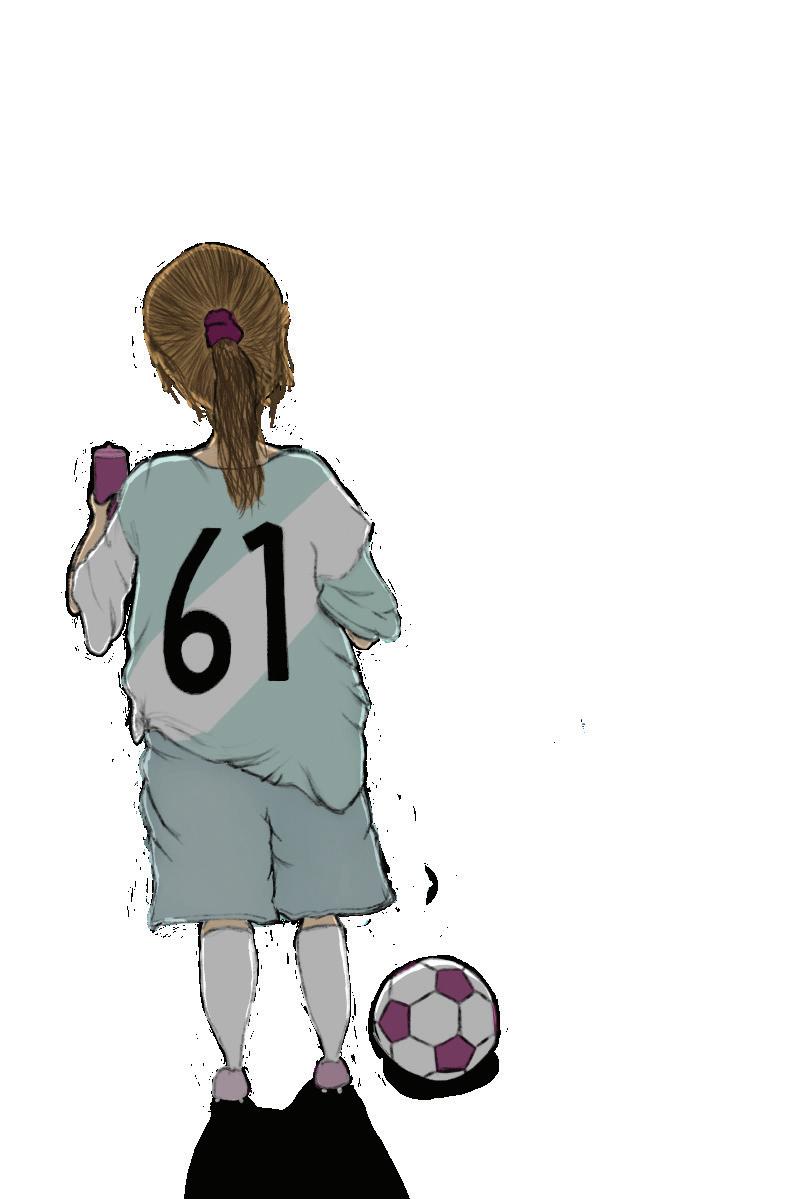
For young athletes to achieve the sorts of accomplishments that Whitham had in the Gotham game, they have to train very seriously from a very young age. As with anything else, becoming genuinely great at soccer requires an immense amount of focus and dedication. To devote that sort of time to a singular sport, most other things—including other athletic pursuits—will almost always fall by the wayside. When young players decide to take a sport seriously, especially as they grow older and get closer to the age of college scholarship offers, players often transition towards playing year-round, often combining school teams, rec leagues, and travel clubs that tend to skew towards being quite competitive and intense.
Thus, there’s a baseline physical risk to a 13-year-old playing professional soccer, because of the degree of specialization required to get to the pros in the first place. And in addition to physical health, the mental strain of playing at the elite and professional levels could pose problems for players’ mental health.
Generally speaking, studies have shown that participating in sports can improve kids’ mental health; athletic participation has been linked to better communication skills and a greater ability to regulate emotions in a healthy manner. That benefit doesn’t necessarily extend to elite youth sports, though, as such a high-intensity environment can very easily

And there’s nothing wrong with that. But that’s a lot of pressure to perform, to excel, to achieve. The situation feels less about Whitham’s capabilities as an athlete and more about what 13-year-olds, regardless of skill level, should be allowed to undertake.
There are a couple of other important caveats here as well. Whitham isn’t listed on Gotham’s official roster. Based on comments from her parents and ESPN reports, she’s been working out and practicing with NWSL teams while also homeschooling and playing for a local travel team. Of course, this is a substantial workload, but it’s not the same as letting a 13-year-old ink a legitimate professional contact before she’s even finished middle school.
Additionally, there is a bit of precedent for this sort of situation. Olivia Moultrie, who currently plays for the Portland Thorns, joined the team at 13. However, she was not allowed to sign a professional contract at the time because of her age—something she would go on to sue the NWSL for. Eventually, after winning that suit, she started playing with the senior team at the age of 15.
Moultrie’s legal victory and subsequent on-pitch success have opened the floodgates for more girls to follow in her footsteps. One of those is Whitham, who has already made history of her own. But these choices, as exciting and inspiring as they seem on the surface, could have potentially serious ramifications. It will be up to time—and the kids who have climbed into the big leagues—to determine whether or not they were making the right call. G
design by ryan goodwin
HALFTIME SPORTS
Scaling the growing mountain of overconsumption
BY BRADSHAW CATE
“Check out my haul from REI!” “Get dressed with me as I prepare for my hike!” “I tried tons of outdoor pants and here are the four you NEED to buy!”
Influencers are showing off their outfits all over social media, reviewing different pieces of clothing and introducing the newest styles for hiking and other outdoor activities. While these videos seem innocent, they point to a new issue facing outdoors enthusiasts: clothing overconsumption. The sheer amount of clothes is starting to pile up, and it’s causing harm to both the environment and the people participating in nature.
Hiking and camping have risen to be the most popular outdoor activities in the United States, creating a new wave of outdoors influencers showing off the idyllic scenery of the Appalachians, Colorado, and hidden worlds you need to find.
Yet this twinflower of popularity has a second bud: the new bloom of athletic wear brands.
First, established brands have seen sales climbing since the 2010s. Patagonia quadrupled its sales numbers during that period, according to a TIME report. In 2023, The North Face sales increased 11 percent.
The ascension of “athleisure” brands, clothing lines that combine comfort with exercise, has given people even more ways to style themselves while immersed in nature. Debuting in 2020, Target’s All In Motion has already reached $1 billion in sales. According to True Fit, sales of athleisure items marketed toward women rose 84 percent a year after the start of COVID-19.
Fortunately, it seems that most outdoor clothing brands pay great attention to preserving the environment with sustainable practices, along with making nature feel accessible to a diverse array of people.
Each year, athleisure brand Lululemon releases an annual report detailing the ways it is making their products more sustainable. Everlane’s website shows off the ways the company weaves sustainability into its production chain and includes an article touting the Glossy Sustainable Brand of the Year award.
What’s more, business writers have heralded Patagonia as the model for corporate social responsibility for the way they support environmentally-focused charities. The company donates one percent of its profits to nonprofit organizations. Patagonia’s website features an
“activism” tab, which directs consumers toward environmental issues where they can make their voices heard. The website also lists over a thousand advocacy groups that people can connect with in their communities.
Certain brands want to increase the inclusivity of the outdoors, too. For example, the North Face’s Explore Fund Council set a framework for how to make nature more inclusive for BIPOC communities and follows through with grants to organizations following their mission.
These initiatives are important, but at the end of the day, these brands are profit-driven companies. No matter how sustainable a clothing line is, there is still a specter antithetical to its claimed values: the need for consumers to buy more.
While Lululemon claims to be meeting climate targets, its overall emissions increased 20 percent from 2022 to 2023 due to the need to move more merchandise. According to a study done by STAND. earth, a nonprofit organization focused on removing fossil fuels from fashion supply chains, Lululemon scored a C- in overall performance. Patagonia and VF, the parent company of the North Face, each received C grades. Columbia, an outerwear company, received a D-.
In Patagonia’s case, while the brand does try to promote sustainability, it still follows fashion industry trends like flooding consumers’ inboxes with deals and promotions, offering free shipping as a reward for spending enough online, and cycling out colors and styles to entice returning customers.
To be fair, overconsumption is not a phenomenon exclusive to outdoor wear. Brands like Patagonia and the North Face reject fast fashion practices that lead to quick disposal of clothes. Yet, the drive to buy has increased the environmental impact of groups claiming to respect it and has harmed the brand’s message of inclusivity.
For example, the urge to buy more outdoor wear harms potential hikers who feel they need to be fashion-forward to be able to enjoy nature.
In the comments section of the aforementioned influencers’ content, many users ask the creator where they got that stylish jacket or how much those pants were.
This creates the mindset that nature cannot be enjoyed without this “essential gear,” the same feeling you get as a kid when you swear you cannot play baseball without those new sunglasses.
What’s more, these companies release new styles and colors of clothing each year to make people feel like they are lacking the latest and greatest. Sports teams do the same, releasing special jerseys each year meant to represent their city, but instead end up alienating fans who cannot keep up with trends.
Nature should inherently be free. Yet, certain clothes can be seen as a “luxury” item, something that confirms your belonging in a space. As a result of this luxury tag, potential hiking hobbyists can feel the sport is exclusive when surrounded by people with the newest and most fashionable gear.
Therefore, those who can afford the financial burden of constant outdoor wear updates drive up the sales of clothing companies, encouraging the retention and expansion of fast fashion practices, while those who cannot are socially barred from the wilderness.
Despite this, the planet is not doomed. There is an undercurrent of creators rejecting this consumption economy. Other influencers on TikTok show how to hike and camp with as little gear and impact as possible. If outdoor brands can live up to their values of sustainability, then the impact of overconsumption can be lessened. Finally, if consumers focus on mending the gear they have and not duplicating their wardrobe, then that mountain of wasted clothes can be overcome. G


11 MARCH 22, 2024 HALFTIME SPORTS design by pia cruz
Signature Theatre’s Penelope is a poignant examination of unraveling
BY HAILEY WHARRAM
Sidelined on a dark shore, a downcast woman waits silently upon a piano bench and listens to the gentle, rippling waves. Penelope’s opening scene is a portrait of tranquility: outfitted in satin garments of jade, lime, and cyan, she shimmers like a sea-glossed gemstone.
Eventually, her voice pierces this serenity, signaling morning’s swift arrival. As sunbeams stream into the scene, bright piano chords ring at her fingertips, and the dawn-dipped plum stage lights warm into electric magenta and fiery orange. Rather than a reignition of hope, the ushering of a new day twists like a knife for this solemn figure: her husband has still not returned home.
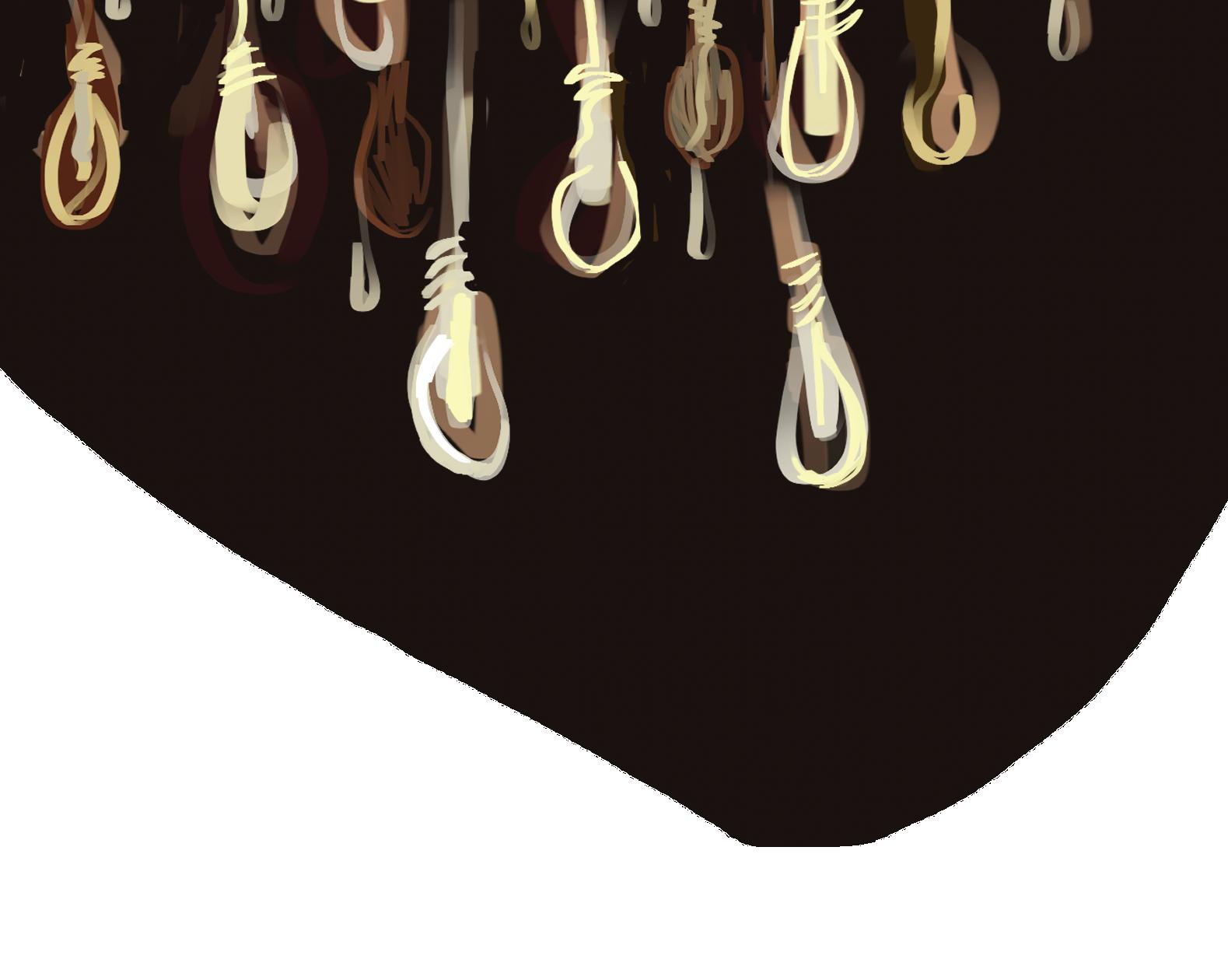
Penelope, an original one-woman musical written by Alex Bechtel running at Signature Theatre through April 21, retells Homer’s The Odyssey through the perspective of Penelope, the wife whom Odysseus abandons for 20 years. Like other stories that center the overshadowed narratives of famous figures’ partners (see Priscilla (2023)), Penelope sees its eponymous lead navigating devastating emotions of neglect. She grapples with one gnawing question: when is it time to let go of the man I love? Anchored by Jessica Phillips’s haunting yet humorous portrayal of Penelope and a brilliant, string-centric score, Penelope is a classical reimagining of mythical proportions.
Amid the blazing sunrise, a quintet slowly takes their places onstage, delivering two simmering instrumental melodies, “A Very Long Wait I” and “One by One,” which delay Phillips’s lyrical introduction for dramatic effect. Like Penelope’s treacherous wait for Odysseus, the audience is forced into patience, given space to grow restless. When we finally meet our lead, the lyrics of “Penelope” acutely reflect this frustration; underscoring her wailing pleas for her husband’s return is her uncertainty regarding how much longer she can keep hope alive.
Juxtaposing this somber beginning, the sonically upbeat “Drunk Iliad” lifts the tempo with a jazzy score and bouncing piano. This sarcastic number sees Penelope clutching a mostly guzzled whiskey bottle while lamenting her husband’s unknown post-Trojan War whereabouts and her complicated, insecurity-laced relationship with Helen of Troy, the woman Odysseus initially favored. Like other songs in the “woman on the verge” musical theater catalog (see “I’m Breaking Down” from Falsettos), “Drunk Iliad” wonderfully balances exposition with palpable, surmounting exasperation, resulting in a song hysterical in more ways than one.
Phillips’s interpretation of Penelope is impressive on multiple fronts. Given the musical’s unique simplicity—a one-woman show with no elaborate sets, costume changes, or props besides a bottle of booze—the production’s success depends almost entirely on her performance. Thankfully, the role could not be in safer hands. Phillips’s voice is stunning; there is a delectable, slightly raspy quality to her tone which perfectly encapsulates the character’s desperation and aggravation. Acting-wise, the Dear Evan Hansen alumna brings the entire palette of Penelope’s complex interiority to life, seamlessly shifting between moments of yearning, annoyance, melancholia, faithlessness, and renewed optimism. Phillips’s evident understanding of this nuanced character is even more impressive considering the expedited rehearsal process; as director Eva Steinmetz revealed after the show, “This woman learned this show in two weeks.”
Phillips’s impressive ability to compensate for the sparse set shines when Penelope invites the crowd to tour her beachside bungalow—a place haunted by memories of her marriage. Without any visual scenery or communicative props, she mimes a series of distinct, repeated gestures to illustrate Penelope’s treasured yet hollowed-out space. Easily one of the production’s most memorable scenes, Penelope describes every hallmark of her house in excruciating detail, including a framed wedding day photograph and a horde of unsavory suitors. When “showing” the crowd her tree-carved bed, a flood of devastating flashbacks washes over her. Overcome by a swelling sorrow, Penelope recalls countless nights spent sleeping alone, sticking her leg out to check if Odysseus might be on his rightful side. Again and again, the cold sheets provide a cruel answer.

The centerpiece of Penelope’s home is her loom. Like the original tale, Penelope promises her suitors that she will settle down as soon as she finishes weaving a funeral shroud for her dearly departed husband. Yet, desperate to keep hope alive, she unravels her progress every night. In “Weaving,” lyrics such as “I make landscapes, I pull them apart,” showcase her tragic arrested development: any semblance of forward momentum eludes her. Torn between wanting to live out the rest of her life and holding out hope for Odysseus’s eventual return, Penelope is stuck in limbo.
This emotional purgatory prompts Penelope to seek solace in religion. Though she prays to Athena every day, she never receives a response … that is, until the number “Tired of Faith.” As she furiously bemoans Athena’s radio silence, the chandelier of lightbulbs dangling above her suddenly starts shaking. Each instrumentalist gazes skyward with glazed-over eyes. Supernaturally overtaken, they begin speaking and singing Athena’s words in unison—a proper Greek chorus.
Susanna Mendlow’s mesmerizing cello forms the song’s bedrock, jauntily tiptoeing across the melody. Similarly, when Penelope unleashes a barrage of questions, Athena tiptoes around the truth, insisting that Penelope should continue to blindly trust her supposedly benevolent intentions (intentions which become increasingly suspicious as Athena refers to the hero as a “macho,” “strapping,” “sinewy” “hunkfest” during her spiel). Though undoubtedly comical—the number concludes with plastered smiles and golden confetti—this ping-ponging conversation also features moments of fascinating contemplation. For instance, when Penelope asks how the goddess of wisdom could possibly have such a gaping blind spot in her knowledge, Athena responds in true erudite fashion: “Penelope, no one sees everything. We know what we see and we only see the things we look for.”

Penelope brazenly embraces duality throughout its 70 minute runtime. The set and story are simple, yet Penelope’s labyrinthine mental landscape is anything but. She craves her lover’s return but simultaneously fantasizes about a life unencumbered by longing altogether. She is the titular lead, but her battles with dependency illuminate the growing pains of writing your own story. Though we encounter Penelope at a time of tremendous uncertainty, one thing remains certain: Penelope is a dazzling production well worth your time. G
12 THE GEORGETOWN VOICE LEISURE design by tina solki
New season, new ambitions: Hoya baseball looks to shine in new stadium
BY ANDREW ARNOLD
There’s a buzz in the air at Capital One Park.
Whether it’s the $5 beers or the Metro trains whizzing by up above, there’s an electric atmosphere building around the new home of the Hoya baseball program. Walk into the brand new ballpark and you’ll immediately feel it. Walk a bit further and you’ll see all the ways the stadium cultivates that lively energy, from its pleasant party deck to the seven-foot-tall “Bruno the Black Bear” statue, to the intimate seating around home plate.
The most exciting thing at Capital One Park, however, has nothing to do with a local animal celebrity-turned-mascot, and everything to do with the Georgetown baseball team.
With the season well underway, Coach Edwin Thompson’s squad has found their groove after a rocky start. The Hoyas are 13-7, are winners of seven of their last eight games, are undefeated at home, and field a dynamic offense that is averaging more than nine runs a game. And while the park they call home may be new, the hot start to the season is no fluke. Thompson took over in 2020, and while he struggled in his first season in 2021 (undoubtedly a product of the difficulties brought about by the first years of the COVID-19 pandemic), his team has gone 32-24 and 30-27 in the past two years—Georgetown’s first winning seasons since 1986. It is no exaggeration to say that Thompson was the exact breath of fresh air this program needed. The Hoyas are no longer loveable losers—they rank 90th out of 305 in the NCAA's rating percentage index (RPI)—and, as far as Thompson is concerned, this is only the beginning.
“We’re at a point in our program where we think that we can go play anybody at any given time. It’s about who plays the best, not who the best team is on paper,” Thompson said in an interview with the Voice
The Hoyas have received contributions up and down the roster, especially on the offensive side of the ball. Senior outfielder Jake Hyde set a program record earlier this year with his 40th career home run, and he only continues to mash, rocking a .313 AVG
with five homers on the year. Junior catcher Owen Carapellotti was a near-unanimous selection to the preseason All-BIG EAST team and has followed up that honor by slashing a cool .282/.441/.563 (AVG/ OBP/SLG) while starting all 20 games behind the dish. Senior first baseman Christian Ficca is hitting a blistering .418 with six homers. Graduate infielder Josh Rolling has 24 hits. The team as a whole is batting an absurd .309 with 184 runs in only 20 games. Everything is clicking.
“Those first three games—Cal, K-State, GCU— we saw a lot of good arms, and I think that was a good weekend to test us. Baseball’s tough, some days you have it, some days you don’t, but we’ve put in a lot of work and Coach has put us in good positions, and we’ll hopefully keep it going and keep working hard like we’ve been doing,” Rolling said in a postgame interview with the Voice. While the program has clearly reached a turning point over the last few years, one of the last remaining hurdles the team faced was finding a true home field. While the Hoyas don’t play on the Hilltop, the university found the team a new, permanent home in Tysons, Va. Opened in March 2023, Capital One Park park is located in the middle of Capital One’s corporate headquarters in Tysons, adjacent to the McLean Metro stop with Silver Line trains chugging along the elevated track right beside the field. The facility is still undergoing construction; Capital One is building an adjacent plaza that is slated to finish in the next year and integrate the whole campus together. The park itself, however, is pristine, and the exact fit the Hoyas were looking for.
“I think it’s just a great atmosphere for college baseball—not too big, not too small. It kinda has that good vibe with the subway going on and feels like you’re in the city. It’s really great and we’ve played pretty good baseball so far here,” Thompson added.
Thompson is not wrong. Capital One Park has been good to the Hoyas; they’re a perfect 8-0 at home, with none of those games even being close. They’ve put up at least 10 runs in five of those games, including two games with over 20.
There’s still work to be done, however. The pitching, for example, hasn’t been nearly as sharp as the hitting. The Hoyas entered the year expecting sophomore righty Cody Bowker to build upon his dazzling freshman year—a 2.57 ERA across 42.0 innings of work, an ERA half that of the team’s—
but he unfortunately sustained an arm injury in a start on March 2 and hasn’t returned to the mound. The defense, too, has been shaky far too often for a team with aspirations of making the College World Series; they’ve committed 33 errors across their 20 games so far. Luckily, there is still time to tune up before conference play begins on March 28 at home against Villanova.
“We’re trying to work on some defensive things—too many errors these last few weeks— and then pitching-wise, we’re gonna get some guys in the right spots and get some guys back from injuries. Once [conference play] starts, it’s a whole new season, but we feel good about our preparation,” Thompson said.
With a tough away series against Ohio State this weekend (ranked 54th by RPI) followed by a rematch with budding DMV rival Maryland (ranked 33rd by RPI) early next week, the Hoyas will have some challenging matchups ahead of themselves before conference play begins. But Thompson’s men have become a metronome of consistency. They aren’t scared of the moment. As the saying goes, iron sharpens iron.
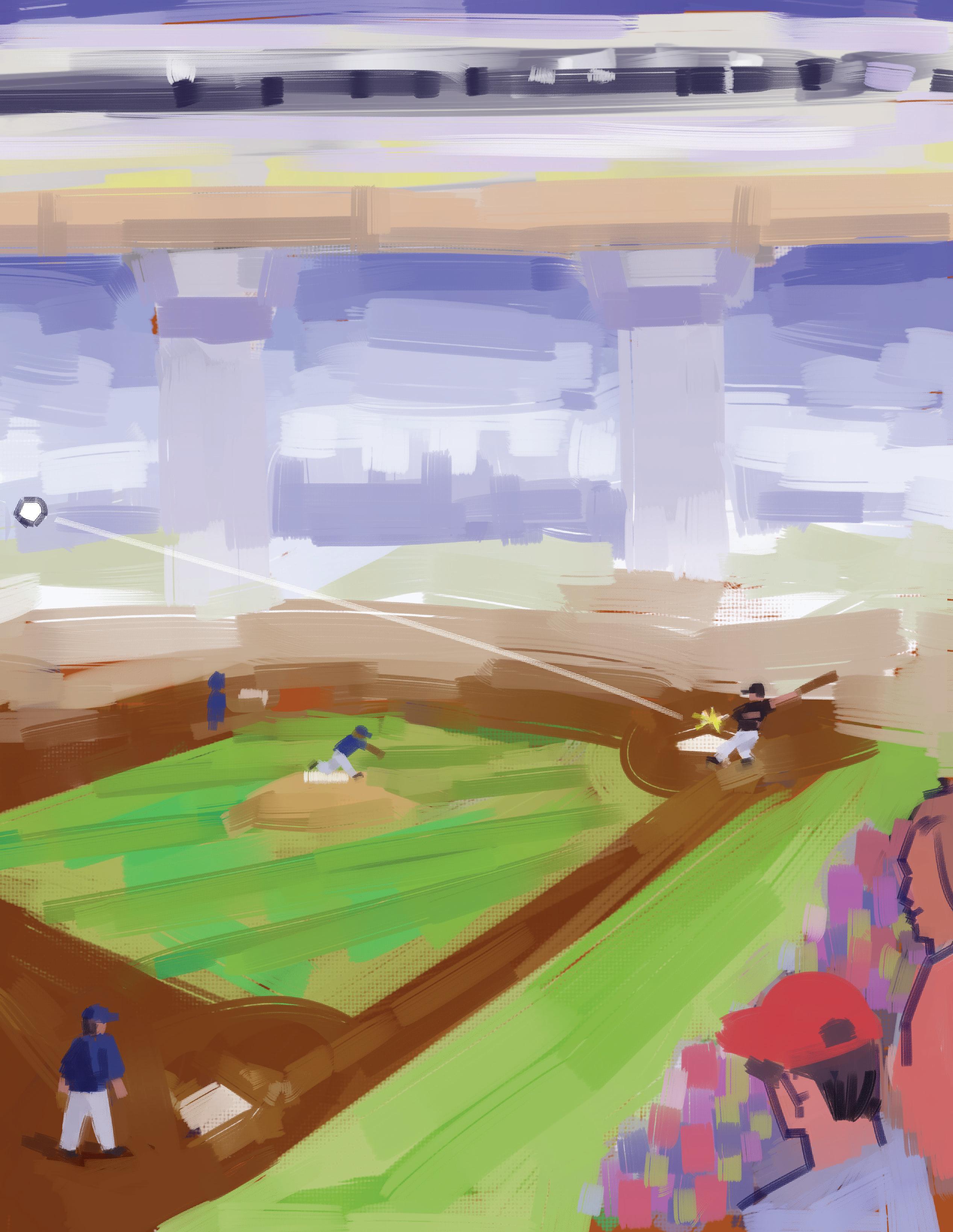
Rolling concluded his postgame interview last Saturday saying, “Anyone can beat anyone—that’s baseball. But I think we definitely have the talent and definitely have the ability to beat anyone.” Time will tell if Rolling’s words will bear fruit, but one thing is certain: these Hoyas are ready for anything. G
13 SPORTS design by paul kang
MARCH 22, 2024
The death of DCist should scare you
BY NORA SCULLY
My journalism classes are rife with discussions about local journalism— which makes sense if you’re entering the field. But outside of the classroom, you may have witnessed some of our conversations play out in real time—the shuttering of local news publications is happening across the country. In the District alone, the Metro section staff at The Washington Post was slashed by 25 percent; the Washington City Paper cut its print issue to solely produce online content; the Wall Street Journal restructured its Washington bureau and laid off several staffers. But on Feb. 23, one of the most devastating blows struck the D.C. community when WAMU decided to close DCist, one of the pillars of local journalism. Fifteen staff positions were eliminated, shocking journalists across the District despite WAMU general manager Erika Pulley-Hayes’s promise that more audio specialist and producer positions would be created. Yet, we must react with more than outrage. We cannot stand by while such valuable, community-oriented publications close their doors.
Since I arrived at Georgetown four years ago, DCist and its coverage of the District has guided the way I developed my journalistic ethos— accessible news grounded in compassion, care, and community. As the fall 2023 editor-in-chief of the Voice, much of our coverage strove to model the efforts of publications like DCist that cover anything from arts and culture events to politics and more. Reporters at DCist have published some of the most impactful articles I’ve ever read, including exposing overtime pay discrepancies in the Metropolitan Police Department—which I analyzed in a data journalism class at Georgetown alongside pieces from nationally recognized publications like The New York Times and ProPublica. It is hard to understate the impact this organization has had not only on myself, but also on the Voice and the larger D.C. community.
There’s no way to analyze the closure of DCist without zooming out to look at the current media landscape and WAMU’s complicated relationship with its online news platform. The shuttering of the DCist website did not happen out of the blue. It was a strategic choice by the Washington-based NPR affiliate to stay afloat amid the turmoil of 21st century journalism.
WAMU acquired DCist six years to the day before their doors closed. In 2018, a series of local journalism publications— including DCist and LAist—closed their doors. But thanks to anonymous donors and a consortium of public radio stations––notably WAMU––the publications remained in operation. It is worth noting that WAMU’s time overseeing DCist was not smooth sailing. According to recently laid-off reporters who spoke with Washingtonian, WAMU’s leadership was a point of frequent contention for DCist staffers. WAMU’s union took to X, formerly known as Twitter, to decry the “poor leadership” decisions that led to the firing. Former WAMU reporter Martin Austermühle described several gaps in staffing that weren’t filled—including a Metro, Maryland, education, and transportation reporter— leaving key subjects undercovered.
While WAMU is a radio powerhouse, coming in at number eight in the Radio Online national ratings, DCist’s role in this “branding” was less clear. When Pulley-Hayes announced the layoffs, she also said that WAMU could now focus on what it does best: radio. However, the dilemma of a public radio station managing a digital news platform doesn’t always end with shuttered windows. When LAist was purchased by KPCC, an LA-based radio station, the two combined under one umbrella organization in January, with the radio adopting the name LAist 89.3. But WAMU doesn’t see a chance for rebranding, apparently. Pulley-Hayes wants to redirect their focus solely to radio coverage, promoting big names like Kojo Nnamdi and his “The Politics Hour.”
It’s hard to know who to blame—a competitive media environment, WAMU leadership, financial difficulties, or all of the above. Since 2005, America has lost more than a quarter of its newspapers, and the rate of decline for local journalism is expected to increase to a third by 2025. Over 500 journalists were laid off in January of this year alone; this exacerbates information deficits in
a country where a fifth of the population already lives in an area without access to local news. And if those statistics don’t scare you, big tech is getting more and more involved in journalism as the cost of print journalism continues to rise. Outlets across the country are trying to answer the question: how do we stay alive?
But the solution for WAMU cannot be to kill off DCist.
Without DCist , this region loses the most comprehensive source of news it had. Reporters and government officials alike decried the move on social media. As residents of the District, the Georgetown community should be concerned. You should be aghast, angry, and all of the negative adjectives. If you want to know about something going on around you, your options are becoming more and more limited. I could talk for hours about the importance of journalism—as a mechanism for institutional accountability, social activities, and engagement—but more importantly, DCist filled a niche of community-centric reporting for the DMV that will now go underserved.
But you don’t have to feel powerless. The union’s gift officer, Sarah Cumbie, is collecting donations on Venmo for impacted WAMU/ DCist staffers. The union is also encouraging individuals to email Pulley-Hayes to demand DCist be saved. Take a moment out of your day to send an email to her at epulleyhayes@wamu.org. Share your thoughts. I’m not confident DCist will return, but expressing care and community is never a waste.
In this media ecosystem, we often take news for granted because there is such an abundance of it. As students, we don’t pay for news; we receive the Times and the Post for free, and if they don’t have the article we need, well, someone else probably does. But there are few organizations who cover local news like DCist , and, I’d argue, none that do it as well. With no paywall, DCist managed to center impacted voices and elevate stories of accountability, joy, and community. So be disheartened, but don’t be rendered immobile by your emotions. Support local journalism now, before it is too late. G

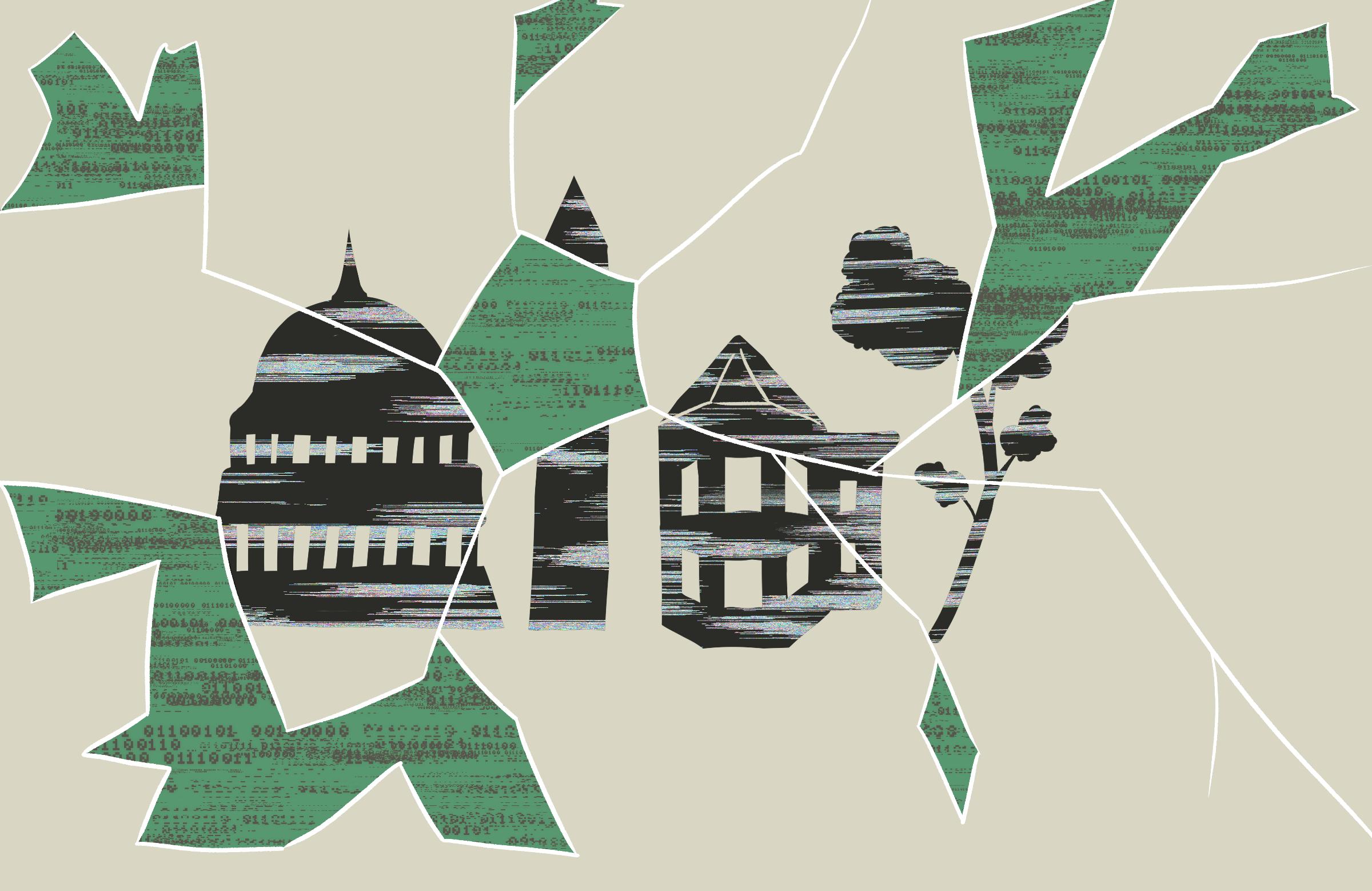
14 THE GEORGETOWN VOICE HALFTIME SPORTS
by
choe
design
elin
VOICES
It’s long past time Georgetown establish an ethnic studies program
BY THE EDITORIAL BOARD
For over 50 years, student activists have pushed for the establishment of ethnic studies programs at universities across the United States. Currently, 43 American universities offer degrees in ethnic studies, and waves of students have demanded that Georgetown implement a similar degree.
It is long past time that Georgetown fulfilled its commitment to social justice and matched its peer institutions by creating an ethnic studies program. This program will work with the existing Black studies department and establish programs in Indigenous studies, Asian American studies, and Latinx studies. The editorial board calls on the Office of the President and the Provost to cluster-hire a group of tenure-line faculty members in these fields who would launch a pilot program in ethnic studies and advance a university-wide ethnic studies pedagogy.
According to UC Berkeley’s Department of Ethnic Studies, ethnic studies refers to the “critical and interdisciplinary study of race, ethnicity, and indigeneity with a focus on the experiences and perspectives of people of color within and beyond the United States.” Its roots can be traced to Freedom Schools, a form of popular education during the Civil Rights Movement that sought to provide an alternative form of education for Black people that reflected their lived experiences and bridged the gaps within the segregated school system. The first collegiate ethnic studies programs grew out of student organizing at San Francisco State University and UC Berkeley in the late 1960s. Since then, similar programs have developed at high schools and colleges across the United States.
Implementing an ethnic studies program at Georgetown is especially important amid nationwide academic censorship. U.S. politicians and school boards have launched a wave of attacks on critical race theory and other discussions of race at educational institutions. But censoring the histories of people of color by labeling these programs as “divisive” is antithetical to the mission of education. Learning should push students to investigate uncomfortable and difficult histories, including the legacies of colonialism, racism, and discrimination in and outside of the United States.
This past September, a proposed Palestinian history program in Santa Ana, Calif., was canceled after pro-Israel advocacy groups filed a lawsuit against the school district alleging that the class
contained inaccurate material and violated the state’s anti-bias guidelines. This is an example of how Israel’s campaign to dehumanize Palestinians and spread disinformation is contributing to academic censorship in U.S. schools. Georgetown must counter this silencing of Palestinian experiences through an ethnic studies program, as prejudiced and ignorant systems of education have contributed to systemic and interpersonal violence against marginalized people throughout history.
An ethnic studies program is also critical for fostering a school environment that supports students of color. Research shows that ethnic studies programs can have long-term psychological and academic benefits for students of color who see themselves reflected in their classroom curricula. Ethnic studies can also teach white students not only to better understand their privilege, but to use this privilege to engage in anti-racist activism.
The wide application of ethnic studies means that all students, regardless of major, can engage in a way that relates to their fields of study. Biology students can learn about the ethics of medical experimentation in the U.S., which has historically occurred nonconsensually at the expense of Black and Indigenous people. Economics students can learn about the vastly increasing racial wealth gap. Performing arts students can learn about the literature and performance of marginalized communities, and so on.
Currently, Georgetown offers a handful of programs on the experiences of various ethnic communities, like the minor in Latin American studies offered by the Center for Latin American Studies. The American Studies (AMST) and Culture and Politics majors also provide enough flexibility for students to pursue coursework on individual ethnic communities through their electives, but this focus is not reflected in their awarded degrees. Moreover, many course offerings in the SFS privilege a U.S. security policy lens in their studies of non-Western peoples, which does not achieve ethnic studies’s aim of embracing the experiences and perspectives of people of color.
The largest barrier to establishing an ethnic studies major at Georgetown is the insufficient number of faculty in these fields. There are only a few professors in Latinx studies and Asian American studies, and there are no professors in Indigenous studies. “Certainly, a larger number
massive and disproportionate burden in terms of teaching and service, and vital fields of inquiry— such as Indigenous studies—remain almost entirely absent.”
The recently renamed Department of Black Studies, founded in 2003 and established as a major in 2016, has 10 tenure-line faculty. Yet it is facing its own challenges in gaining legitimacy as a department at Georgetown. “We are [seen as] contributing to either superficial and simplistic DEI initiatives or to the university's reconciliation mission regarding slavery,” Professor Lamonda Horton-Stallings, chair of the Department of Black Studies, wrote in an email to the Voice. Beyond gaining institutional legitimacy, Black studies continues to face challenges in hiring, space issues, and a lack of library materials.
One way the university has considered alleviating the challenges associated with creating new departments is by integrating new ethnic studies fields, such as Asian American Studies, within the AMST program. This would serve as a stepping stone to a larger research and teaching program in these fields. “But the existing structure and orientation of AMST should not determine the eventual shape that ethnic studies takes on,” Hochman wrote in an email to the Voice. While housing ethnic studies within AMST may provide momentary institutional stability, an ethnic studies program should exist independently in the long term.
The President and Provost must coordinate a cluster-hire of tenured faculty in ethnic studies and related fields. By centering the lived experiences of people of color, ethnic studies embraces an educational pedagogy that resists structures of oppression and exploitation. Investing in ethnic studies at Georgetown is essential for recognizing knowledge and epistemologies outside the white, Eurocentric norm. G


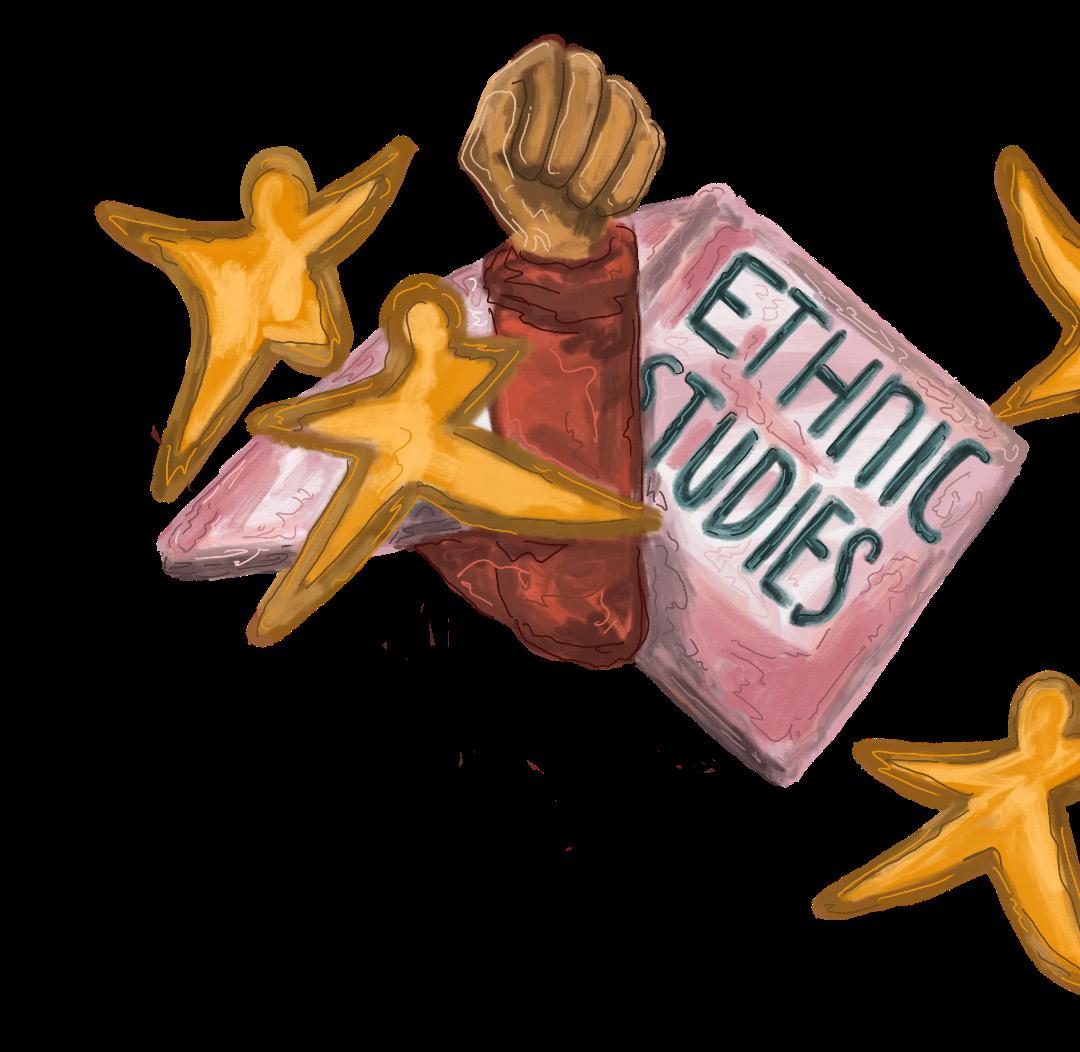
design by grace nuri
EDITORIALS 15 MARCH 22, 2024

YOUR PHOTO HERE. DETAILS ON PAGE 3. SUBMISSIONS DUE 4/4.
 By Nora Scully
By Nora Scully

















































